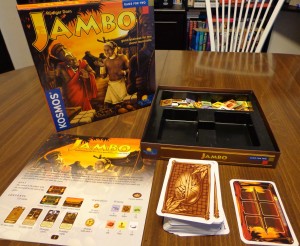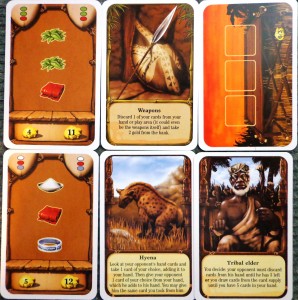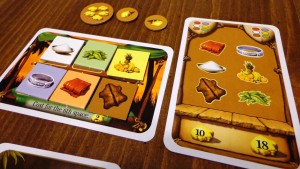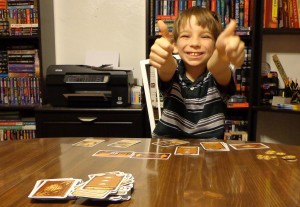Buy low…sell high. No matter what business you’re in, this concept is pretty popular, especially if you are interested in making money. Whether it’s goods or services, making a profit is generally a good thing, and that is exactly your goal in the game of Jambo.
Jambo is a two player game that tasks players with earning sixty gold before the other player by buying and selling wares. Each player will have a marketplace that will temporarily hold the wares they’ve purchased, and then players will sell those wares once they get the cards that enable them to do so. Let’s take a look at the components and gameplay before heading into the review.
Components
Cards – Cards make up the majority of gameplay, allowing players to buy and sell wares as well as perform special actions.
Gold – These cardboard pieces will allow players to keep track of how much gold they’ve earned.
Wares – These cardboard pieces are placed on market stand cards when bought and help players keep track of which wares they currently own.
Action Markers – There are five action markers, which help players keep track of how many actions they’ve used on a turn.
Cards
Market Cards:
Small market stands cost three gold to purchase, except for the very first one, which costs six. The sixth space on the large market stand must be rented at two gold per use, so players should only use that sixth space unless they can make a profit from it.
Ware Cards:
The bottom left corner of the ware card lists the purchase price of all of the wares listed on the card. The bottom right corner of the ware card lists the sell price of all of the wares listed on the card. Wares must be bought as a whole, meaning that you must buy or sell ALL of the items listed. If you don’t have the space in your market stands for even just one or two wares, you can’t buy them…and if you don’t own all of the wares listed, you can’t make a sale.
Utility Cards, People Cards, and Animal Cards:
Players can have three utility cards in front of them at one time, each one can be used once per turn for one action. Utility cards might allow players to draw extra cards or trade cards in for gold…players will be able to choose which ones work for them best. People and animal cards are often a one time use that either helps one player or hurts the other.
Setup & Gameplay
Shuffle all of the cards except for the two large market stand cards. Each player gets a large market stand card (red or green), five cards from the deck, and twenty gold. The starting player is chosen at random.
On a player’s turn, they have five actions and can perform the following:
Phase One – Draw Cards:
Drawing a card costs one action. If the player does not want the card, they can discard it and draw another, which costs another action. This phase ends when they draw and keep a card. If a player used all five actions (drawing five cards and keeping the fifth one), they do not get to go on to the next phase and their turn ends.
Phase Two – Play Cards:
Playing a card costs one action, unless a card says otherwise. Players will be able to buy additional small market stands to expand their inventory space, purchase or sell wares, and play a variety of other cards that change gameplay in some way. If a player ends their turn with two actions (or more) in reserve, they get a free gold piece.
Players continue taking turns until one person earns sixty gold. Whoever does first, wins!
The above is simply an overview of the game. To read about the game in more detail, you can check out the manual here:
The Review
The game is extremely simple to play, which surprised me a bit. Often in card games like this, getting used to the card types and their effects can take a little time. In the case of Jambo, the cards were easy to understand and neither Vinnie (11) nor myself had problems understanding what they did. The cards themselves are nice to look at and convey information relatively well. The manual does a good job in explaining how the game works, though some of the explanations felt long-winded.
There is a fair amount of strategy involved, especially when picking and playing utility cards. My son enjoyed playing the “scale”, which allowed him to draw two cards, pick one to keep, and give me the other one. This worked to his advantage, but I was enjoying a steady stream of cards as a result. The limited space on the market stands will make players think twice before buying up the first ware cards that they are presented with. I often waited to buy until I had a similar ware card that I could quickly use to sell the wares I just bought. Later in the game as I purchased markets stands, I was able to buy wares from two or three cards at a time, then use one or two to sell some of them. Luck comes into play a bit as you sometimes may not draw the ware cards you need to sell the wares you have. The game does offset this by giving certain action cards the ability to sell any wares you want, but at a reduced price.
Vinnie summed up his review with one short sentence, “This is a great game right here.” The game was simple enough for him to play but complex enough that it didn’t bore him. He enjoyed buying up all of the wares he could, though often didn’t understand the concept of making a profit. When he bought six wares for twelve gold, then sold three wares for twelve gold, he made the comment that he was right back where he started. It was my job as father and accountant to explain the concept of “assets” and their value. After a while, it began to sink in.
Overall, I really enjoyed my time with Jambo. I highly recommend it for couples or for when a parent wants one on one time with their kid. Excellent, excellent game.
Final Verdict: 9/10
—




